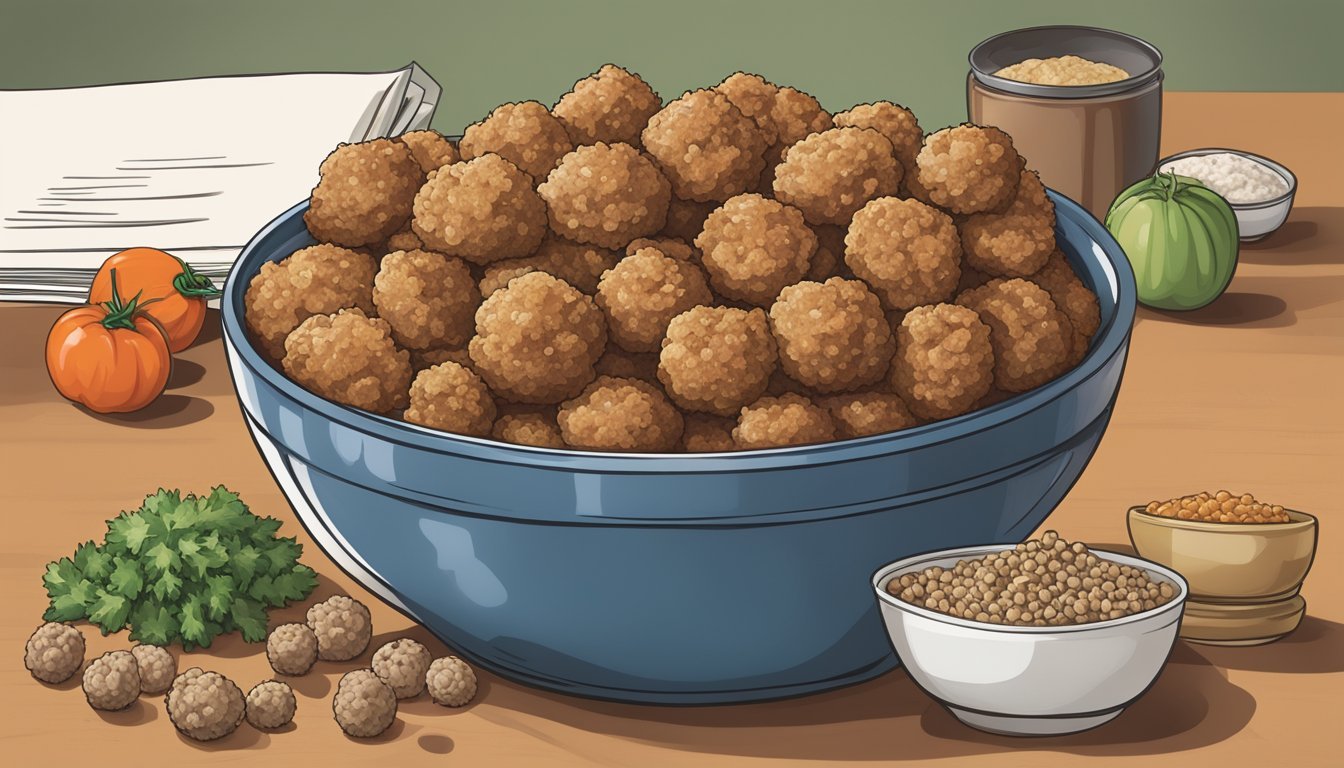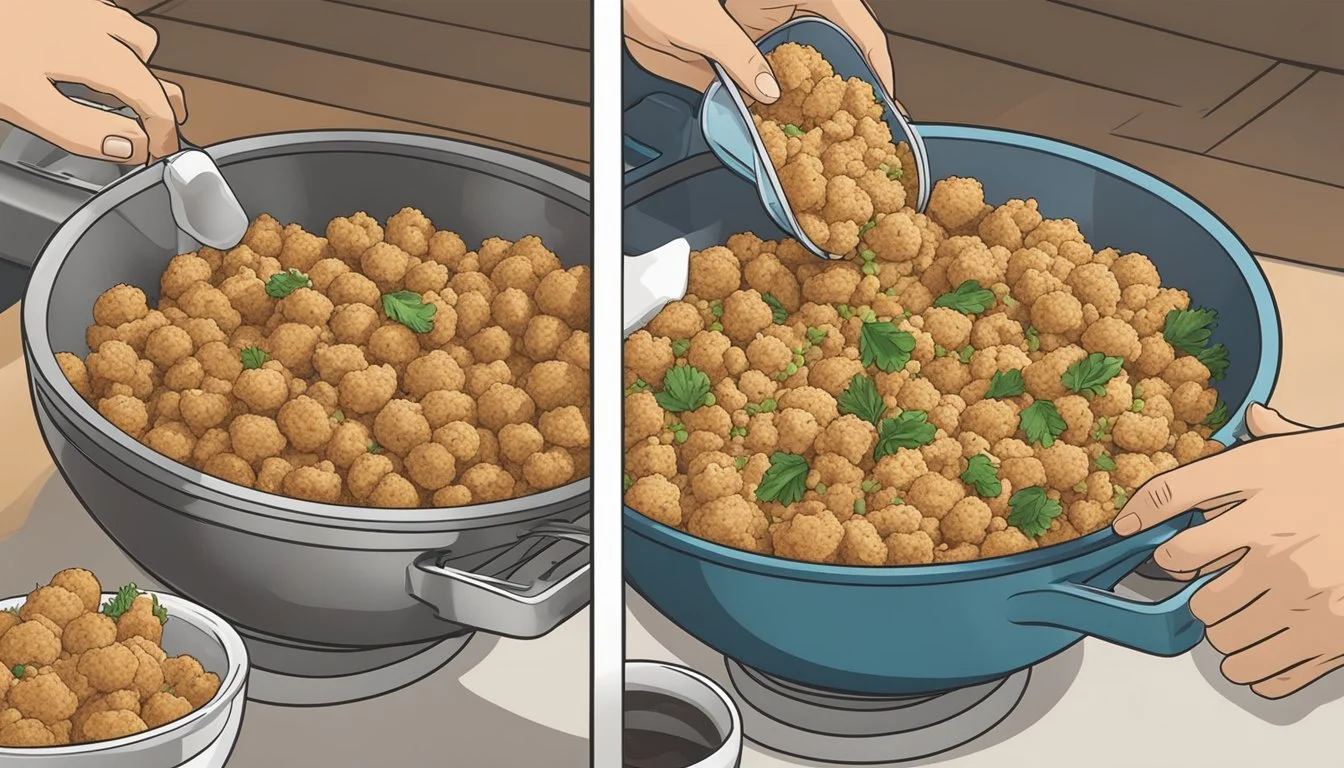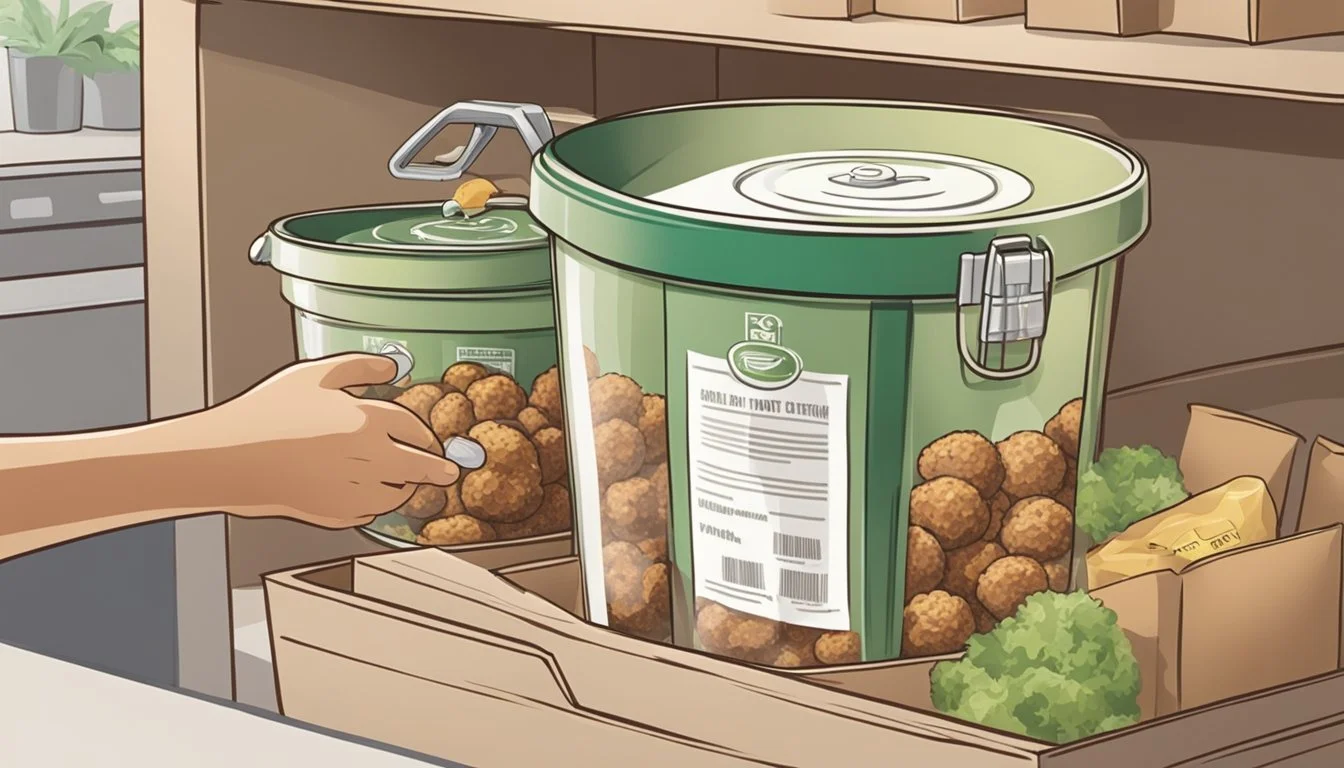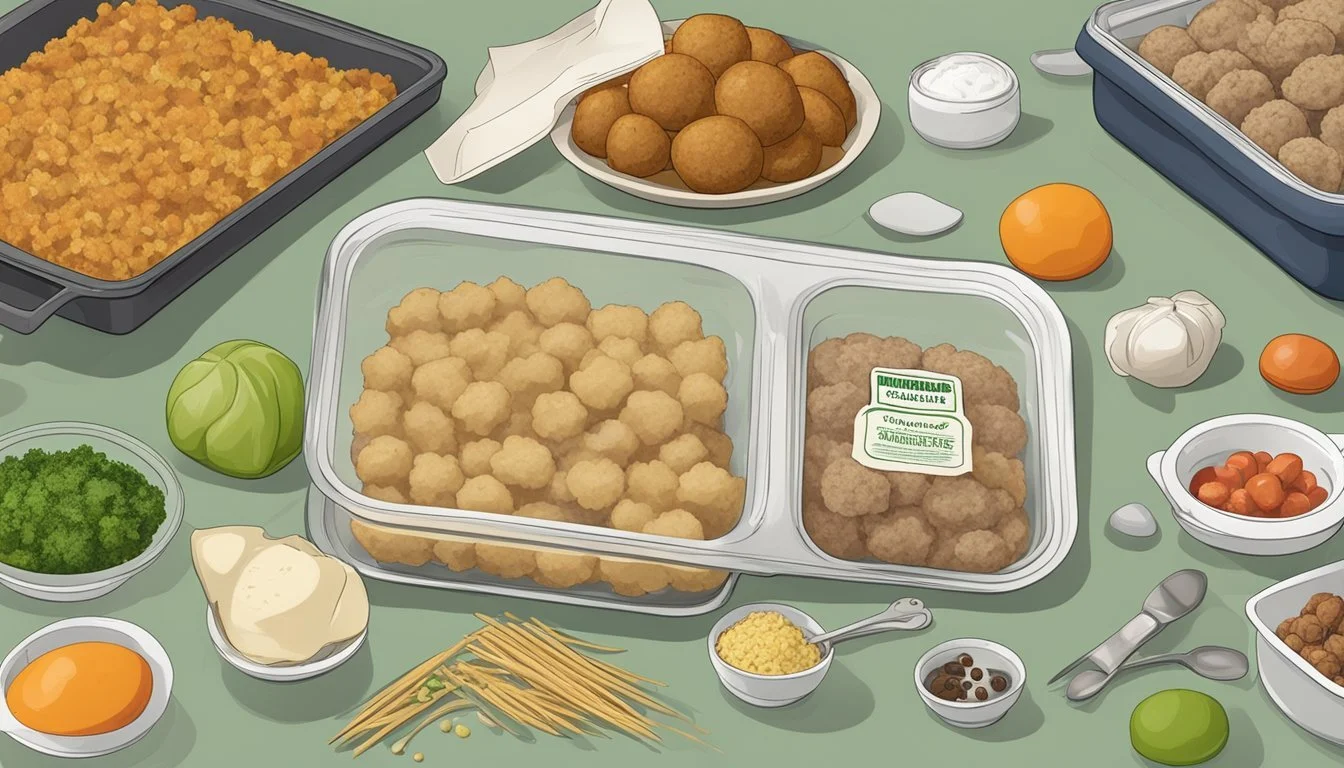Boxed Stuffing Mix Meatball Binders
Perfecting Your Recipe with Ease
Boxed stuffing mix, typically associated with holiday feasts, is finding new life in kitchens as a versatile binder for meatballs. This pantry staple carries with it the savory flavors of herbs and spices, along with a bread crumb texture that is well-suited for holding meatball ingredients together. Whether one opts for a traditional Thanksgiving-like turkey (What wine goes well with turkey?) and stuffing combination or ventures into more uncharted culinary territories, boxed stuffing provides a convenient and reliable means to create meatballs with a rich and aromatic taste profile.
Incorporating stuffing mix into meatball recipes not only lends the dish a distinctive flavor but also offers an efficient way to achieve a desired consistency. The dehydrated bread cubes or crumbs function as absorbents for moisture from other ingredients, ensuring that the meatballs maintain their shape during cooking without falling apart. The seasoning within the mix eliminates the need for additional herbs and spices, streamlining the preparation process.
This approach appeals to both seasoned cooks looking to innovate traditional recipes and to newcomers aiming for simplicity in their cooking endeavors. The use of a boxed ingredient boosts confidence in the kitchen by reducing the number of variables in a recipe, thus ensuring consistent results. Moreover, it exhibits a knowledgeable use of available resources, demonstrating that a clear understanding of the characteristics of ingredients can lead to new culinary creations.
The Basics of Boxed Stuffing Mix Meatballs
Boxed stuffing mixes are a convenient and flavorful binder option for crafting perfect meatballs, combining herbs, seasoning, and bread or breadcrumbs in a single package.
Understanding the Role of Binders in Meatballs
Binders are crucial in meatball preparation; they act like glue, holding the meat and other ingredients together. Without an effective binder, meatballs can fall apart during cooking. Common binders include eggs and milk, which, when mixed with a dry element like breadcrumbs or boxed stuffing mix, create a paste that adheres to the meat and maintains the meatball's shape.
Eggs: Rich in proteins that coagulate under heat, providing structural integrity.
Milk: Adds moisture to the meat and helps to bind the stuffing mix or breadcrumbs to the meat.
Selecting the Right Stuffing Mix
Choosing the correct type of boxed stuffing mix is vital for both texture and flavor of the meatballs.
Flavor: Select a stuffing mix that complements the meat's flavor; traditional herb mixes are versatile.
Texture: Opt for a fine mix to ensure it blends smoothly with the meat and other ingredients.
For optimal results, the stuffing mix should be combined thoroughly with the ground meat and other ingredients such as minced garlic, chopped onions, and seasonings like oregano or Italian seasoning, before forming the mixture into balls. This not only instills the meatballs with a rich flavor profile inherent to the stuffing mix but also ensures a consistent texture throughout.
Preparation Techniques
When using boxed stuffing mix as a binder for meatballs, the preparation process is crucial for achieving the right texture and flavour. Accurate measurement and proper mixing lead to perfectly consistent meatballs, while appropriate shaping and baking ensure well-cooked results.
Mixing Ingredients for Consistency
To begin, preheat the oven to 400 F. One should mix the dry stuffing mix with other ingredients, such as ground turkey or chicken, and a binding liquid—preferably chicken broth—to enhance the flavor. The addition of an egg is often recommended to help bind the mixture. It is essential to mix the ingredients until they are just combined to avoid tough meatballs.
Example of a basic recipe mixture might include:
1 lb ground turkey
1 6 oz box of stuffing mix
3 tbsp chicken broth
1 large egg
Shaping and Baking Meatballs
Once the meatball mixture is thoroughly combined, the next step is to shape them. Using clean hands or a tool such as a meatball scoop or a melon baller, one should create uniform balls, typically 1 to 1 ½ inches in size. It's important to place them evenly spaced on a parchment paper-lined baking sheet, which aids in an even bake and easy cleanup.
One must bake the meatballs in the preheated oven; a good start is at 400 F for about 15-20 minutes. However, the cook should always use a meat thermometer to ensure the meatballs reach the safe internal temperature of 165 F for poultry. Proper baking yields a brown and slightly crisp exterior with a juicy interior.
Seasoning and Flavor Enhancement
The right combination of herbs, spices, and vegetables can elevate the taste of meatballs made with boxed stuffing mix, ensuring a flavorful dish.
Choosing Herbs and Spices
When seasoning meatballs, start with the foundational flavors of salt and black pepper to enhance the natural taste of the ingredients. To add depth, one may consider garlic powder for a subtle, aromatic piquancy. For a classic profile, sage, parsley, thyme, and rosemary can each be added for their respective piney and earthy notes. Nutmeg, though less common in savory dishes, offers a warm undertone that pairs well with ground meats.
Herbs & Spices:
Salt: To taste
Black Pepper: 1 teaspoon
Garlic Powder: 1 teaspoon
Sage: 1/2 teaspoon
Parsley: 1 tablespoon, chopped
Thyme: 1/2 teaspoon, dried
Rosemary: 1/2 teaspoon, finely chopped
Nutmeg: A pinch
Incorporating Vegetables
Vegetables are a crucial addition not only for their nutritional value but also for their flavors and textures. Celery and onion, finely diced, should be sautéed until they're soft and translucent, which releases their sweetness and complements the savory elements of the meatballs. Garlic, when minced and briefly cooked, imparts a savory zest that intertwines well with the stuffing mix and the selected herbs.
Vegetable Add-Ins:
Celery: 1/2 cup, finely diced
Onion: 1 cup, finely chopped
Garlic: 2 cloves, minced
Pairing with Sauces and Sides
Boxed stuffing mix meatballs offer a unique twist on traditional flavor profiles and pair well with classic sauces and side dishes. The meatballs serve as a savory canvas for a variety of complementary tastes, ranging from rich gravies to tangy cranberry sauces.
Gravy and Cranberry Sauce Suggestions
Gravy: A velvety gravy made from a roux base can envelop the meatballs in a rich, savory sauce. One might opt for a traditional turkey gravy, simmered until it reaches the desired consistency, to enhance the herbaceous notes of the stuffing.
Cranberry Sauce: They can also be brightened up with a dollop of cranberry sauce. Whether one prefers a smooth jelly or a whole-berry sauce, the tartness of cranberries cuts through the richness of the meatballs and gravy, providing a pleasing contrast.
Complementary Side Dishes
Mashed Potatoes: Fluffy mashed potatoes make an excellent accompaniment to meatballs with stuffing mix, creating a comforting and filling meal. The creaminess of the potatoes pairs harmoniously with the dense texture of the meatballs.
Cornbread: For a Southern twist, one might serve the meatballs with cornbread. Its slight sweetness and crumbly texture offer a pleasing counterpoint to the meatballs' savory flavors.
Green Beans: A side of steamed or sautéed green beans provides a crisp, fresh contrast to the hearty meatballs, adding color and balance to the plate.
Serving and Presentation
When using boxed stuffing mix as a binder for meatballs, one can effortlessly elevate both the flavor and presentation of this versatile dish. These meatballs can effortlessly transition from a casual potluck to an elegant Thanksgiving dinner with the right plating and serving approach.
Plating for Appetizers and Main Courses
For appetizers, presentation is key. Serve the meatballs on a platter with toothpicks for easy handling. Arrange them in a circular pattern around a bowl of gravy or dipping sauce. For a Thanksgiving dinner or Friendsgiving, present the meatballs on a decorative dish garnished with fresh herbs like parsley or sage, which complement the herby seasoning of the stuffing mix.
When serving as a main course, plate the meatballs atop a bed of mashed potatoes or a side of seasonal vegetables. Drizzle gravy generously over the meatballs to enhance their succulence and provide a visually appealing contrast.
Additional Serving Ideas for Gatherings
At more relaxed gatherings such as potlucks, consider offering the meatballs in a keep-warm pot or slow cooker. This approach allows guests to serve themselves and ensures that the meatballs remain hot throughout the event.
Serving Method Description Keep-Warm Pot Ideal for self-serving and maintaining an optimal temperature. Platter Arrangement Suitable for appetizers; can be styled with greenery and sauces for visual flair. Family Style Serve on a large dish for communal eating, fostering a shared dining experience.
In summary, whether one aims for the simplicity of a potluck or the sophistication of a carefully plated meal, boxed stuffing mix meatballs are both an easy and tasty choice that can be seamlessly incorporated into any gathering, making it a delightful option for hosts seeking to impress with minimal effort.
Storage and Reheating
Preserving meatballs made from boxed stuffing mix extends their shelf life and ensures flavors are retained when it's time to enjoy them again. Proper storage and reheating are crucial for maintaining taste and safety.
Preserving Leftovers
After meatballs cool to room temperature, they should be placed in an airtight container. They can be stored in the refrigerator for up to 3-4 days. For longer preservation, meatballs can be frozen. To freeze, one should lay them on a baking sheet, spaced apart, until they are solid. Then, transfer the frozen meatballs to a freezer bag, removing as much air as possible, and they can be stored for up to three months.
Reheating for Best Quality
When reheating leftovers, the method can affect their quality. For refrigerated meatballs, they can be warmed in a preheated oven at 350°F (175°C) until heated through, which typically takes about 20 minutes. If meatballs were frozen, they can be reheated directly from the freezer. In a saucepan, place frozen meatballs in marinara sauce, cover and simmer over medium-low heat, stirring occasionally. This should take about 20 minutes until they are heated thoroughly.
Health and Dietary Considerations
When using boxed stuffing mix as a binder for meatballs, individuals should be mindful of the nutritional content and consider options that cater to various dietary restrictions.
Nutrition Disclaimer
The use of boxed stuffing mix in meatball recipes can add refined carbohydrates, sodium, and potential allergens to the dish. A typical recipe incorporating 93% lean ground turkey and stuffing mix may offer a leaner protein choice, but the additional ingredients in the stuffing could affect a person's dietary goals. It is essential to read nutrition labels for a clear understanding of the meal's impact.
Alternative Ingredients for Dietary Restrictions
For those with dietary restrictions, alternatives to traditional boxed stuffing can be employed to maintain nutritional balance:
For gluten sensitivities: Choose gluten-free stuffing mixes or substitute with gluten-free breadcrumbs.
For lower-carbohydrate options: Use almond flour or grated Parmesan cheese in place of traditional stuffing mix.
To reduce sodium: Opt for a low-sodium stuffing mix or make a homemade version with controlled salt levels.
For a leaner meal: Utilize ground turkey breast which has less fat compared to other ground meat options.
By considering the ingredients in boxed stuffing mixes and seeking alternatives, one can adapt meatball recipes to align with various health and dietary needs.
Advanced Tips and Variations
Crafting meatballs using boxed stuffing mix provides a quick and flavorful binder for a multitude of recipes. Whether it's for Thanksgiving meatballs or more turkey recipe exploration, this section dives into expanding your meatball repertoire with varied ingredients and flavors.
Expanding the Meatball Recipe Repertoire
When innovating meatball recipes, one can consider different stuffing mix varieties. Cornbread stuffing mix, for example, provides a sweeter base, excellent for balancing savory turkey stuffing meatballs. To maximize the Thanksgiving theme, incorporating leftover stuffing into meatballs infuses tradition and reduces waste.
Here's how one can expand their meatball repertoire:
Utilize cornbread stuffing mix for a Southern twist, pairing well with turkey or chicken.
For Thanksgiving meatballs, mix in cranberries or diced sweet potatoes for festive flair.
Enhance stuffing meatballs by adding fresh herbs like sage or rosemary for depth of flavor.
Experiment with using leftover stuffing as the meatball base, adding beaten eggs to bond the ingredients.
Remember, the secret to moist meatballs lies in the moisture content of your stuffing mix. If using leftover stuffing, ensure it's not too dry. A splash of broth can reinvigorate the stuffing for a perfect meatball mixture.
Frequently Asked Questions
In this section, readers will find detailed answers to common queries about using boxed stuffing mix as a binder in making savory and juicy stuffing meatballs. The content provides confident and clear guidance to ensure a successful cooking experience.
Addressing Common Concerns
Can I use boxed stuffing mix for meatballs?
Yes, one can use boxed stuffing mix as an effective binder for meatballs. It imparts a savory taste and a pleasing texture, making the meatballs both flavorful and well-structured.
Will meatballs made with stuffing mix be too dry?
Not if prepared correctly. The key to keeping stuffing meatballs moist and juicy is to ensure that the mixture isn't overworked and that there's enough liquid, such as broth or milk, to keep the mix from being too dry.
Is it quick to prepare meatballs with stuffing mix?
Yes, using stuffing mix is a quick way to prepare meatballs since it's already seasoned and only requires the addition of a few wet ingredients to bind.
How long should I rest the meatballs before cooking them?
It's beneficial to let the formed meatballs rest for about 15-20 minutes before cooking. This allows the stuffing mix to absorb moisture and helps the meatballs maintain their shape during cooking.
Expert Advice on Preparation and Cooking
What is the best way to ensure a warm, savory taste in the meatballs?
To achieve a warm and savory taste, incorporating finely chopped aromatic vegetables like onions, garlic, or celery into the meatball mixture is advised. This enhances the flavor profile provided by the stuffing mix.
What's the recommended technique for cooking stuffing mix meatballs to maintain their texture?
For the best texture, meatballs should be cooked evenly. This can be achieved through baking in an oven set to around 400°F for 20-22 minutes, or until fully cooked through. Alternatively, they can be pan-fried until browned and then simmered in sauce.
By addressing these common concerns and providing expert advice, cooks can confidently use boxed stuffing mix to create delicious meatballs with a satisfying taste and texture.










